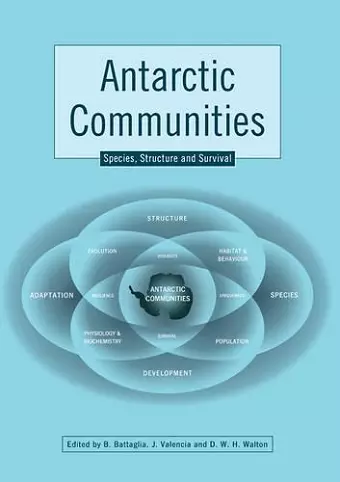Antarctic Communities
Species, Structure and Survival
David Walton editor Bruno Battaglia editor Jose Valencia editor
Format:Paperback
Publisher:Cambridge University Press
Published:11th Jun '09
Currently unavailable, and unfortunately no date known when it will be back

Conservation of biodiversity is best achieved through the management of natural communities, but progress in increasing our understanding of communities remains slow. The study of Antarctic communities can provide a valuable step forward in investigating the control of community development, the utilisation of habitats and the interaction between species in both species-rich and species-poor communities. This book contains chapters characterising the current approaches to both aquatic and terrestrial communities in the Antarctic. From biodiversity to trophic flows, from ecophysiological strategies to the impacts of environmental change and the effects of human disturbance, this volume provides an up-to-the-minute overview of community studies in an area covering ten per cent of the Earth's surface.
"This book is of interest mainly to biologists with professional interests in the chapter topic and it is to them that the book is recommended." Wildlife Activist
"Without a doubt, scientists working on the biology of polar regions should have this book on their shelf. It will also be an invaluable reference for ecologists concerned with life in extreme environments, conservation biology, and global change biology. It is well organized and contains many examples of community interactions that can and should be applied on a global scale. The editors are to be applauded for their selection of chapters, which represent contributions from 15 countries and cover virtually all of the habitats supporting life on or associated with the Antarctic continent." John C. Priscu, BioScience
"...this book makes two major contributions to the existing literature on antarctic research. First, it expands our understanding of antarctic ecology at the level of communities adn ecosystems.... Second, it strengthens the perspective of Antarctica as an interactive component of the global environment, both affecting and being affected by larger scale processes such as climate change. Thus, this book would make a solid addition to any library of antarctic research." Daryl L. Moorhead
"This volume presents an impressive array of biological research carried out in the Antarctic region. ...of high quality.... ...the editors of this book have been successful in drawing together a diverse and impressive summary of the state of our knowledge concerning Antarctic ecosystems, which should attract a wide audience of biologists." Knut Kielland, The Quarterly Review of Biology
ISBN: 9780521111799
Dimensions: 297mm x 210mm x 24mm
Weight: 1100g
484 pages